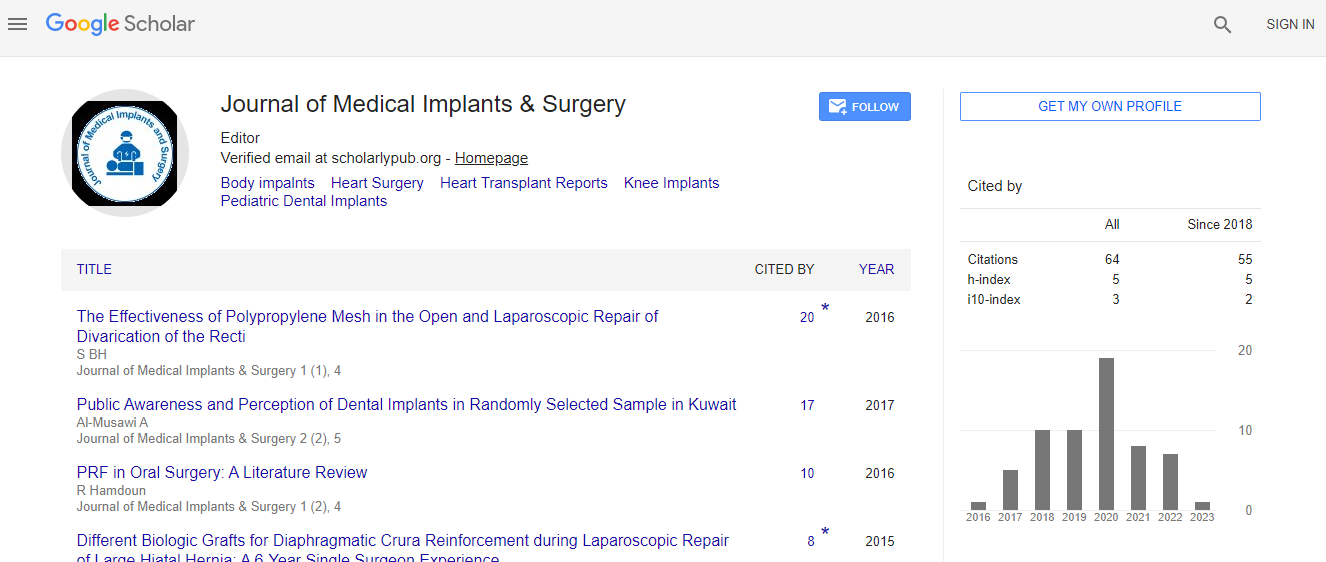Research Article
Different Biologic Grafts for Diaphragmatic Crura Reinforcement during Laparoscopic Repair of Large Hiatal Hernia: A 6-Year Single Surgeon Experience
Reznichenko AA*
Department of Surgery, Tulare Regional Medical Center, CA 93274, USA
- *Corresponding Author:
- Reznichenko AA, M.D, Ph.D
Department of Surgery
Tulare Regional Medical Center, CA 93274, USA
Tel: +1 559-688-0821
E-mail: areznik9@yahoo.com
Received Dtae: October 12, 2015; Accepted Date: November 23, 2015; Published Date: December 10, 2015
Citation: Reznichenko AA (2015) Different Biologic Grafts for Diaphragmatic Crura Reinforcement during Laparoscopic Repair of Large Hiatal Hernia: A 6-Year Single Surgeon Experience. J Med Imp Surg 1:101.
Copyright: © 2015 Reznichenko AA. This is an open-access article distributed under the terms of the Creative Commons Attribution License, which permits unrestricted use, distribution, and reproduction in any medium, provided the original author and source are credited.
Abstract
Background: Large hiatal hernias represent a challenge for surgeons. Biologic grafts are currently popular for the strengthening of crural closure during laparoscopic repair. This study is a retrospective review of crural reinforcement in laparoscopic repair of large hiatal hernias using various biologic grafts performed by a single surgeon in a rural community hospital.
Methods: Eleven (n=11) patients underwent laparoscopic repair of large hiatal hernia in a rural community hospital by a single surgeon from 2009 to 2015. Standard laparoscopic hiatal hernia repair was performed. Different biologic grafts were used for crural reinforcement, including “AlloMax”, “Permacol”, and “Acell MatriStem”. Perioperative data and outcomes of surgery were evaluated.
Results: There were six females and five males, mean age was 55.4 years, mean BMI was 32.5. Eight patients had type III hiatal hernia, two patients had type IV, and one patient had type II. Mean operative time was 244.6 minutes, and mean length of stay was 3.3 days. Mean size of herniated stomach in the chest was 62%. Mean sizes of the hiatal defect was 7.7 cm × 6.4 cm. One perioperative complication (9%) included bleeding from left gastric artery. Early complications included shortness of breath (18%), parapneumonic effusion (18%), and early dysphagia (18%). Late complications included persistent gastro esophageal reflux (9%), gastroparesis (9%), and persistent dysphagia (9%). Radiological recurrence was 18% and clinical recurrence was 9% at mean follow up of 15 months.
Conclusions: Laparoscopic repair of large hiatal hernia could be safely performed in rural community hospitals. The choice of the biologic graft, if one is used, should be at the discretion of the surgeon. The cost and availability of the biologic graft is important in decision making.

 Spanish
Spanish  Chinese
Chinese  Russian
Russian  German
German  French
French  Japanese
Japanese  Portuguese
Portuguese  Hindi
Hindi 